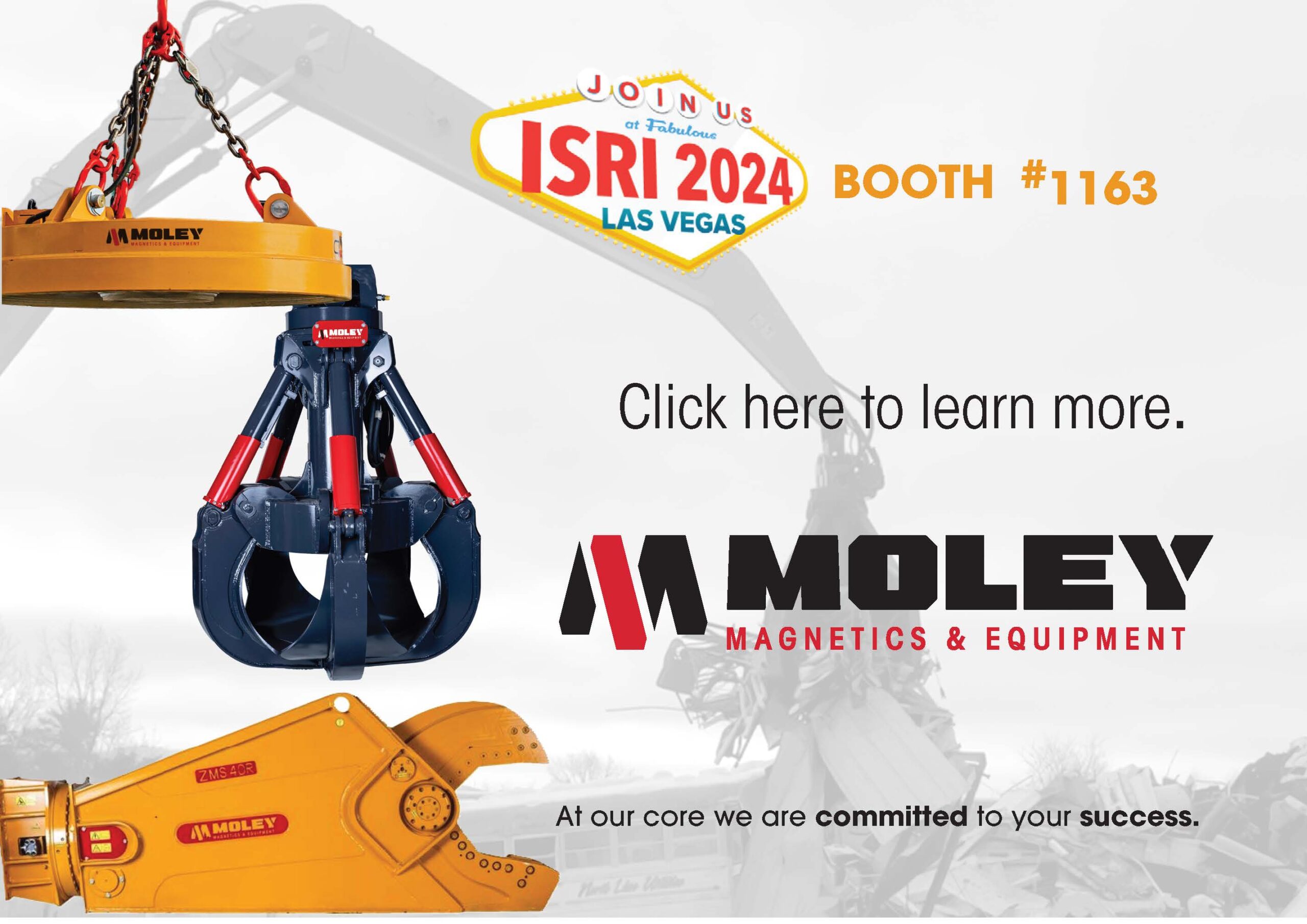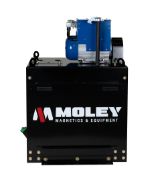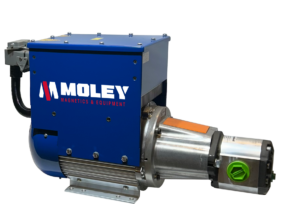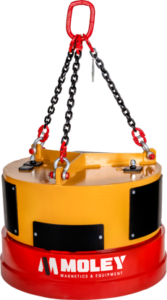A Case Study of the Moley Excavator Scrap Shear
Introduction:
Efficiency is critical in recycling operations to maximize productivity and minimize operational costs. This case study explores how the integration of the Moley Excavator Scrap Shear improved efficiency and streamlined operations at a leading recycling facility.
Background:
The Recycling Facility, a prominent player in metal recycling, encountered challenges in processing large volumes of scrap metal efficiently. Their primary shear was not reliable, leading to bottlenecks and reduced throughput. Seeking a reliable, safe, and effective solution, the Recycling Facility explored various equipment options and decided to integrate the Moley Excavator Scrap Shear into their operations.
Implementation:
The integration of the Moley Excavator Scrap Shear represented a significant milestone in the Recycling Facility’s pursuit of operational excellence. Strategically positioned within the facility, the scrap shear seamlessly integrated into existing workflows. Moley provided comprehensive training to operators, ensuring optimal utilization and safety compliance.
Results:
The introduction of the Moley Excavator Scrap Shear resulted in tangible improvements in efficiency, safety, and productivity:
- Fast Cycle Times: In scrap processing, time efficiency is crucial. The Moley Magnetics Excavator Scrap Shear is meticulously engineered to optimize productivity with rapid cycle times. Its quick jaw opening and closing speeds enable the recycling facility to process a larger volume of materials in less time, thereby enhancing operational efficiency. Additionally, due to downtime and performance issues with their old shear, when the recycling company replaced it with a Moley shear that was in stock, it allowed them to resume operations quickly. Our ability to deliver the shear promptly minimized downtime and increased the volume of scrap processed each day, thanks to its reliability.
- Durability: Recycling operations require strength and endurance, which is why our excavator scrap shear is built to withstand the harshest conditions. Constructed from high-quality materials and engineered with a reinforced cylinder and a fully enclosed upper body, our shear is designed for longevity. It can endure daily use and withstand the impact of heavy-duty scrap materials, ensuring consistent performance and reliability over time. The recycling company was experiencing downtime with their previous shear. Our shears run every day with regular maintenance, ensuring continuous operation.
- Cutting Force: Our excavator scrap shear shines when cutting through a diverse range of scrap materials. The hardened piercing tip of the upper jaw maximizes productivity when piercing is necessary. Equipped an optimized jaw design, it delivers remarkable cutting force, effortlessly slicing through thick steel beams and various other materials, efficiently processing even the toughest scrap the previous shear couldn’t.
- Versatility: Our Excavator Scrap Shear is a versatile attachment that seamlessly mounts onto a variety of excavator models. This adaptable design allows for a multitude of applications, including demolition, recycling, and material handling. Whether in construction, metal processing, or waste management, our shear serves as the ideal tool to streamline operations and maximize efficiency and is even used on more than one excavator in the recycling yard.
Conclusion:
The integration of the Moley Excavator Scrap Shear proved transformative for the Recycling Facility, delivering significant improvements in efficiency, productivity, safety and operational agility. By leveraging innovative technology, the facility achieved streamlined processing workflows, reduced operational costs, and enhanced competitiveness in the recycling industry. This case study highlights the critical role of advanced equipment solutions in driving operational excellence and sustainable growth in recycling operations.
See the Moley Excavator Scrap Shear on YouTube
Made in America: The History of American Railroads

Have you taken a moment to consider the significance of railways in our lives, transporting people and goods across the nation? Although trains might not be a daily sight for everyone, they play a vital role in shaping America and its identity. From the early days of discovery to high speed transit, the narrative of American railroads is marked by innovation, determination, and evolution. Early
Beginnings
The roots of American railroads can be traced back to the early 19th century, a time of industrialization and westward expansion. In 1828, the Baltimore and Ohio Railroad Company laid the first commercial track in the United States, marking the beginning of a transportation revolution. Initially designed to transport goods and raw materials, these early railroads soon expanded to accommodate passengers, connecting growing cities and fueling economic growth.
The Golden Spike
It’s May 10, 1869 at Promontory Summit, Utah and perhaps the most iconic moment in American railroad history – east meets west. The Union Pacific and Central Pacific railroads met, linking the east and west coasts of the United States with the driving of the ceremonial “golden spike.” This event represented a monumental achievement of engineering and ingenuity, shrinking the distances of the American continent and forever altering the course of our nation’s history.
The Age of Expansion
In the years following the completion of the transcontinental railroad, railroad construction boomed across the United States. Railroad companies raced to lay track across the plains, through mountain passes, and into remote territories, driven by the promise of land grants, government subsidies, and the prospect of tapping into new markets. Railroads became the lifeblood of American industry, transporting goods, people, and ideas with unprecedented speed and efficiency.
Building the Rails
Constructing railroads in America was not an easy task. It required extensive labor, funding and engineering expertise. Workers were faced with grueling conditions to lay track, blast tunnels, and bridge rivers. Entire towns sprang up along the rail lines, fueled by the influx of workers and the demand for goods and services.
Innovation and Progress
The history of American railroads is also a story of innovation and progress. Railroad barons such as Cornelius Vanderbilt, Jay Gould, and James J. Hill revolutionized the industry through consolidation, technological advancements, and strategic investments. From the development of the steel rail and the steam locomotive to the introduction of diesel-electric engines and high-speed rail, American railroads continually evolved to meet the demands of a changing world. The last few decades
1940’s – 1970’s
Railroads modernized their maintenance and construction practices with attachments such as grapples and electromagnets including battery magnets. These attachments are valuable tools for efficiently lifting and moving heavy steel plates, spikes, rails, and other materials. The electromagnets, powered by electricity, could be attached to cranes or other machinery, allowing railroad workers to easily manipulate and transport materials along the tracks and within rail yards. This innovation significantly streamlined railroad maintenance and construction processes, contributing to increased productivity and safety in the industry.
1970s-1980s
The 1970s and 1980s were a challenging period for the railroad industry. Facing competition from other modes of transportation such as cars and airplanes, passenger numbers, decreased and government regulations increased. In response, the government passed the Railroad Revitalization and Regulatory Reform Act of 1976, which aimed to stabilize the industry by providing financial assistance and deregulating certain aspects of rail operations.
1990s-2000s
The 1990s and 2000s saw a revival of the railroad industry. Increased demand for freight transportation, fueled by globalization and e-commerce, led to a revitalization of the freight rail sector and railroad construction. Railroad companies invested heavily in infrastructure upgrades, technology, and efficiency improvements, resulting in a more reliable and competitive rail network. Additionally, the privatization of passenger rail services, brought about improvements in service quality and operations.
2010s-2020s
In the 2010s and early 2020s, American railroads continued to evolve in response to changing market dynamics and emerging trends. Technological advancements, such as Positive Train Control (PTC) systems and precision scheduled railroading (PSR) techniques, helped improve safety, efficiency, and capacity on rail networks.
Environmental concerns and sustainability initiatives also drove investments in cleaner, more fuel-efficient locomotives and alternative fuels. The growth of intermodal transportation, where goods are transported using multiple modes (e.g., rail and truck), became increasingly important in meeting the demands of modern supply chains. High-speed rail projects, although slower to develop compared to other countries, gained traction as a means of reducing congestion, cutting emissions, and improving passenger connectivity in select regions.
Conclusion
From humble beginnings to the present day, the history of American railroads is a testament to the power of human ingenuity and determination. What began as a means of connecting distant cities and territories has evolved into a vital artery of commerce, culture, and connectivity.
As America continues to look toward the future, the iron threads of its railroads play a critical role in shaping the nation’s destiny.
Do you want to learn about the future of railroads? Check out this article about the future of rail.
Concrete Pulverizer Demonstration
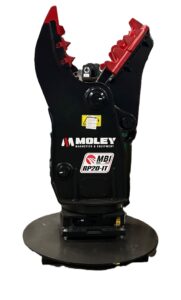 Snow, rain, or shine, we are always tested by the weather in our line of work. Here in Lockport, NY, Mother Nature keeps us on our toes – it’s April, yet it’s still snowing! Despite the weather, Moley Magnetics has an unwavering dedication to meeting our customers’ needs.
Snow, rain, or shine, we are always tested by the weather in our line of work. Here in Lockport, NY, Mother Nature keeps us on our toes – it’s April, yet it’s still snowing! Despite the weather, Moley Magnetics has an unwavering dedication to meeting our customers’ needs.
Recently, a customer requested a specific demonstration of our fixed pulverizer, and naturally, we were eager to accommodate. Since we have a number of skilled staff members this was an easy request. Our fabrication shop built the bracket and then we had one of our technicians hop into the cab of the excavator. He quickly showed how our fixed pulverizer can crush concrete into small pieces. As he worked the pulverizer, we couldn’t help but appreciate the peaceful ambiance of the snowfall around us.
These fixed concrete pulverizers are primarily used to crush concrete on the ground, often employed for the processing of concrete removed from rail construction sites or demolition sites. Once the concrete is crushed, it can be recycled and repurposed, providing it with a new lease on life.
Beyond their ability of destruction, concrete pulverizers play a role in promoting environmental sustainability. By crushing concrete structures onsite, these concrete pulverizers reduce the mass of the concrete and therefore reduce the waste transported from the site. Furthermore, it may seem like the end for the crushed concrete but it can also be start of a new life. Crushed concrete can be recycled and repurposed for a variety of construction projects.
Of course, we informed the customer that we would be delighted to demonstrate how our fully enclosed hydraulic claw magnet or demolition grapple can support clean up after the pulverizer has done its job. The hydraulic claw magnet is designed to separate rebar once it’s freed from the concrete and the grapple can pick and move the concrete pieces to a container for transport.
Our commitment to providing effective solutions remains unswerving, regardless of the weather conditions. We understand the importance of delivering quality service while adapting to challenges. In Lockport, where the weather can be unpredictable, our capable team is always prepared to tackle any task.
As we continue to face the elements in our work, we take pride in our ability to not only meet but exceed our customers’ expectations. Whether it’s snow, rain, or sunshine, we remain dedicated to delivering exceptional results and ensuring customer satisfaction because at our core, we are committed to our customers’ success.
Speaking of the elements, Lockport, NY, is in the path of the solar eclipse on Monday, April 8. You can bet we’ll take 5 to witness this once-in-a-lifetime event!
At our core, Moley Magnetics is committed to your success!
Check out the video mentioned in this article below.
The Value of Tradeshows and ISRI 2024
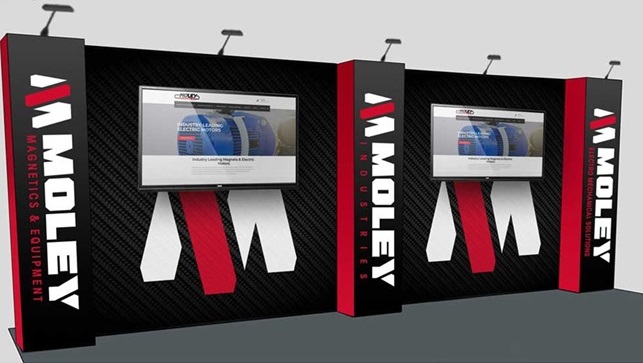
Tradeshows are a cost-effective way to be informed of industry trends and emerging technologies. By bringing together multiple vendors in one location, attendees gain the advantage of comparing many products without the need for extensive travel. Maximizing both time and travel expenses becomes feasible through attendance at events such as ISRI 2024, hosted in the fabulous city of Las Vegas.
Tradeshows offer opportunity for professionals to immerse themselves in the latest advancements and innovations within their particular industries. With an array of suppliers showcasing their products and services under a single roof, attendees are afforded the convenience of exploring various offerings in a consolidated setting. This consolidation of resources not only streamlines the decision-making process but also minimizes the logistical challenges associated with visiting multiple suppliers individually.
The significance of attending tradeshows extends beyond mere convenience; it serves as a stage for networking and knowledge exchange. Engaging with industry peers, experts, and thought leaders facilitates meaningful discussions and insight into emerging trends and best practices. Such interactions often lead to valuable connections and collaborations that can augment professional growth and development.
Additionally, tradeshows provide a firsthand experience of products and technologies, allowing attendees to assess their suitability and functionality in real-time. Through product demonstrations and hands-on experiences, individuals gain deeper insights into the features, benefits, and potential applications of various offerings. This experiential learning enhances decision-making processes and facilitates informed choices regarding investments in new technologies or solutions.
In addition to product showcases, tradeshows frequently feature educational seminars, workshops, and keynote presentations delivered by industry experts. These sessions offer valuable insights into market trends, regulatory updates, and emerging challenges, providing attendees with the knowledge and tools necessary to navigate an ever-evolving business landscape. Likewise, participation in such educational opportunities enhances professional credentials, continuous learning and skill development.
The financial advantages of attending tradeshows are undisputable. By consolidating multiple vendor interactions into a single event, attendees significantly reduce travel expenses, accommodation costs, and time away from the office. This cost-effective approach to networking and business development maximizes ROI while ensuring access to a diverse range of products, services, and expertise.
ISRI 2024 provides a prime opportunity for industry professionals to capitalize on these benefits. Held in the vibrant city of Las Vegas, this premier event promises a dynamic showcase of progressive technologies including scrap magnets, innovative solutions, and industry insights. Whether seeking to explore new business opportunities, stay ahead of market trends, or forge valuable connections, ISRI 2024 offers a comprehensive platform for professional growth and advancement in the scrap and recycling industry.
Tradeshows represent a cost-effective and efficient means for industry professionals to stay informed, network, and explore new opportunities. By bringing together a diverse range of vendors, products, and expertise, these events offer unparalleled convenience and value. Make the most of your time and resources by attending ISRI 2024 in Las Vegas, and unlock the full potential of your professional endeavors. Don’t forget to stop and see Moley Magnetics in booth #1163 where we can share how our scrap magnets, orange peel grapples and mobile shears can help your business.
Do you want to learn more about our products? Check out YouTube channel.
Optimal Power for Your Magnet Generator
Choosing the best magnet power source for your application
Power is required when it comes to the operation of magnets, and determining the right energy source for your specific application is important in operational success. Whether your work is railroad construction, railroad cleanup, scrap recycling, or demolition, the prerequisites for powering your operations can exhibit considerable diversity.
When exploring power source options such as a diesel magnet generator, hydraulic magnet generator or a fully enclosed hydraulic magnet, these options can be tailored to meet varying demands. Among these, a diesel generator is noted for its exceptional fuel efficiency and established legacy within the industry. These systems, though robust and dependable, often boast larger physical footprints compared to their hydraulic counterparts and include their dedicated engines, which contribute to their long-lasting reputation.
In contrast, the hydraulic magnet generator option is a more compact alternative, characterized by its condensed stature and ingenious utilization of the Power Take Off (PTO) mechanism. By leveraging the PTO on the host apparatus to which it’s installed, this generator foregoes the need for an independent engine, illustrating efficiency and allowing many options for installation.
Meanwhile, the fully enclosed hydraulic magnet epitomizes innovation by combining the magnet and generator systems into a single unit. Enclosed by a lid, the generator and its associated components are seamlessly integrated, giving operators a compact, streamlined solution that epitomizes efficiency and convenience including the fact that a dedicated machine is not required, and it can be easily transported from site to site.
There are many options and navigating the landscape to identify the most fitting power source for your specific needs may pose some planning and consideration of your needs. Should uncertainty cloud your decision-making process, our seasoned professionals are ready to offer guidance and support. With an unwavering commitment to facilitating informed decisions, Moley Magnetics is dedicated to assisting you in selecting a power source that complements seamlessly with your operational requirements.
Power lies at the core of magnet operation, and the mission to identify the best energy source is a mission full of significance. Whether it’s the tried-and-tested diesel generator, the agile hydraulic magnet generator, or the innovative fully enclosed hydraulic magnet, each option gives its unique advantages, promising flexibility and efficiency in equal measure.
Check out Moley products in action on YouTube
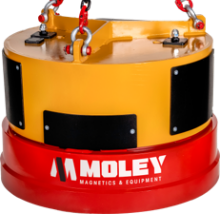
How Hydraulic Generators Work
A hydraulic generator uses a compact hydraulic motor instead of diesel engines, which reduces size weight and noise levels of the generator. Energy transmission occurs when hydraulic flow is applied to the hydraulic motor and turns the generator which produces energy. Hydraulic hoses connect to the motor, allowing the generator to be installed in a variety of places, including a compartment, on top of the apparatus body, or within engine housings.
Routine inspections are critical for the generator’s performance and preventing potential issues. These inspections involve various aspects, including visual checks, assessment of fluid quality, pump operation, validation of valve functionality, examination of electrical components, and comprehensive system testing.
Visual inspections require examination of the hydraulic generator’s components, inspecting for visible signs of wear, damage, or abnormalities. This includes assessing the state of hydraulic hoses, electrical connections, hydraulic motor, fittings, and as well looking for potential leaks or issues. Regular visual inspections are key to addressing potential problems.
Monitoring the quality of hydraulic fluid is important for proper lubrication and functioning of the hydraulic system. Regular checks involve assessing hydraulic fluid clarity, consistency, and cleanliness to identify any signs of contamination, fluid degradation, or insufficient levels. Maintaining high-quality hydraulic fluid helps prevent premature wear and damage to system components and extends the life of the hydraulic generator.
The electrical components of the hydraulic generator include inspections of wiring, connections, and controls. This process involves checking for loose connections, damaged wiring, or faulty components that may impact electrical supply or control signals. It is also important to test electrical systems under load conditions helps to identify potential issues such as voltage fluctuations or power surges, enabling timely corrective actions to maintain system integrity and safety.
Moley Magnetics’ fully enclosed hydraulic magnets have a number of advantages including faster installation to the machine than a traditional system and an entire machine does not need to be dedicated. Simply move the magnet from machine to machine or site to site saving time and transportation costs. To learn more about Moley Magnetics hydraulic generators and fully enclosed hydraulic magnets, and to explore how they can benefit your operations, don’t hesitate to contact us today. Consider checking out our educational series on fully enclosed hydraulic magnets here.
A 2 in 1 Tool: How a Claw Magnet Works
In material handling, innovation continues to play a pivotal role in streamlining processes and enhancing efficiency. One innovation that has proven to be critical is the claw magnet which is a type of hydraulic magnet for excavators. This powerful tool, often used in scrapyards and construction sites, operates on a mechanism designed for precision and versatility. In this article, we’ll dive into the intricate workings of a claw magnet, unraveling the functionality.
Understanding the Basics
A claw magnet is a lifting device that uses an electromagnetic system to attract and hold ferrous materials firmly. The claw-shaped design adds an extra layer of functionality, to
loosen up dirt, gravel and other debris, allowing access to metal pieces.
Electromagnetic Activation
The key to the hydraulic magnet for excavators operation lies in its electromagnetic activation system. When the magnet is energized, an electromagnetic field is generated. This magnetic force is what enables the magnet to attract and securely grip ferrous materials, ranging from scrap metal to construction debris.
Claw Design for Versatility
The claw design sets the claw magnet apart from its counterparts. The claw serves a special purpose, it provides a gripping mechanism that enhances control during material handling. The versatility of the claw design allows the magnet to efficiently scrape and dig for materials of various shapes and sizes.
Precision Control for Material Handling
One of the standout features of a claw magnet is its ability to provide precision control during material handling operations. The claw allows operators to selectively uncover specific items, maximizing the material recovered. This precision is particularly valuable in scrapyards and construction sites where sorting and organizing materials are integral parts of the process.
Swift Activation and Deactivation
The speed at which a claw magnet can be activated and deactivated is a significant advantage. The electromagnetic system allows for near-instantaneous magnetization and demagnetization, contributing to a seamless and efficient workflow. This swift activation and deactivation enable operators to precisely control the claw magnet’s interactions with materials, enhancing overall productivity.
Safe Distance Operation
Safety is a top priority in material handling operations, and the claw magnet is designed with this in mind. Operators can control the magnet from a safe distance, minimizing the risk associated with handling heavy and potentially hazardous materials. This feature enhances the overall safety of the workplace, making the claw magnet a reliable and secure tool.
Application in Diverse Environments
The versatility of the claw magnet extends to its application in diverse environments. From scrapyards to construction sites, the claw magnet excels in handling various materials, including but not limited to scrap metal, iron components, and other ferrous items. Its adaptability makes it a valuable asset in industries requiring efficient and precise material handling.
Conclusion
In conclusion, the claw magnet’s functionality leverages electromagnetic principles, and specific design making it a versatile attachment for many applications. Its ability to provide swift activation, holding strength, and precision control sets it apart as a reliable and efficient tool for material handling. Whether in scrapyards, construction sites, or other industrial settings, the claw magnet proves to be an indispensable asset, unlocking new levels of efficiency and control in material handling operations.
The Benefits of Using a Hydraulic Scrap Magnet
In the world of material handling, efficiency is key, and the deployment of specialized tools can make a big difference. One excavator attachment that has transformed the material handling, particularly in scrapyards and construction sites, is the fully enclosed hydraulic scrap magnet. In this article, we’ll go into the advantages and applications of using a scrap magnet, exploring how this innovative technology enhances the operations of those in the scrap metal and construction industries.
Swift and Precise Material Handling
One of the primary advantages of utilizing a hydraulic scrap magnet is the ability to swiftly and precisely handle ferrous materials. Traditional methods of sorting and moving scrap metal can be time-consuming and labor-intensive. The hydraulic magnet for excavators, allows operators to easily lift, move, and deposit metal materials with precision, reducing the overall processing time and increasing operational efficiency.
Streamlining Scrapyard Operations
In scrapyards, where the volume of metal materials can be overwhelming, the hydraulic magnet becomes an invaluable asset. Equipped to an excavator, this magnet streamlines the collection and organization of scrap metal. It efficiently lifts ferrous materials, enabling operators to navigate through piles with ease and accuracy. The result is a more organized and efficient scrapyard operation.
Cost-Effective Material Handling
The cost-effectiveness of using a hydraulic magnet cannot be overstated. By significantly reducing the manual labor required for handling metal materials, businesses can save on labor costs and allocate resources more efficiently. The speed at which the hydraulic scrap magnet operates also contributes to time savings, allowing for higher throughput and increased productivity.
Enhancing Safety in Material Handling
Safety is a top priority in any setting, and the hydraulic magnet plays a critical role in enhancing safety during material handling operations. By enabling operators to control the magnet from a safe distance, the risk associated with manual handling of heavy and potentially hazardous materials is alleviated. This is particularly beneficial in scrapyards and construction sites where safety measures are principal.
Minimizing Environmental Impact
The hydraulic scrap magnet not only offers operational advantages but also contributes to environmental sustainability. In scrapyards and recycling facilities, efficient material handling means better sorting and recycling practices. The ability to lift ferrous materials ensures that recyclables are separated effectively, minimizing waste and reducing the environmental impact of metal processing operations.
Versatility in Construction Site Cleanup
Beyond scrapyards, the hydraulic scrap magnet proves its versatility in construction site cleanup. Construction projects generate a significant amount of metal debris, and they hydraulic magnet for excavators becomes a powerful tool for rapidly clearing construction sites. This not only accelerates the cleanup process but also contributes to a safer and more organized site.
Maximizing Resource Recovery in Demolition Projects
In demolition projects, the hydraulic scrap magnet maximizes resource recovery by efficiently separating ferrous materials from the demolition debris. This not only streamlines the waste management process but also allows for the recovery of valuable metals, contributing to a more sustainable and economically viable approach to demolition.
Customization for Excavator Compatibility
Hydraulic magnets for excavators are designed with compatibility in mind. They can be customized to fit various excavator models, ensuring that businesses can choose a magnet that seamlessly integrates with their existing equipment. This customization adds a layer of flexibility, allowing businesses to optimize their material handling processes based on specific operational needs.
Conclusion
The utilization of a scrap magnet in material handling operations brings multiple benefits. From increased efficiency and cost-effectiveness to enhanced safety and minimized environmental impact, the advantages are clear. Whether in scrapyards, construction sites, or demolition projects, the hydraulic scrap magnet proves to be a versatile and indispensable tool for businesses aiming to elevate their material handling capabilities.
Moley Magnetics offers attachment solutions tailored to your needs, including magnet grapples, scrap magnets, hydraulic generators, shears, and pulverizers. Contact our experts today.
Hydraulic Magnet for Sale: Complete Buying Guide
Investing in a hydraulic magnet for your excavator can be a game-changer for your material handling operations. However, with various options available in the market, choosing the right hydraulic magnet requires careful consideration. In this buying guide, we’ll explore key factors to help you make an informed decision when searching for a hydraulic magnet for sale.
Understanding Your Excavator’s Specifications
Before diving into the world of hydraulic magnets for sale, it’s crucial to understand your excavator’s specifications. Hydraulic magnets for excavators come in different sizes and configurations, so knowing the lifting capacity, hydraulic flow rate, and compatibility with your excavator model is essential. Consult your excavator’s manual or speak to a professional to ensure a seamless integration of the hydraulic magnet with your equipment.
Assessing the Type of Materials to be Handled
The type of materials you intend to handle with the hydraulic magnet play a substantial role in your purchasing decision. Hydraulic magnets are designed for lifting ferrous materials, but the weight, size, and shape of these materials can vary. Consider the range of materials in your operational environment, from scrap metal to construction debris, to choose a hydraulic magnet with the appropriate lifting capacity and configuration for best performance.
Customization Options
A reputable hydraulic magnet provider will offer customization options to meet your specific needs. Whether it’s adjusting the magnet’s size, modifying the attachment mechanism, or incorporating additional features, having a hydraulic magnet tailored to your requirements ensures most efficiency in your material handling operations. Inquire about customization options when exploring different hydraulic magnets for excavators.
Engaging the Magnet
Engaging the hydraulic magnet for excavator is a critical aspect to consider. A smooth and quick magnetic engagement process enhances efficiency in material handling. Look for hydraulic magnets that offer a user-friendly and responsive engagement mechanism. This ensures that your excavator operator can easily control the magnet, contributing to a more seamless and productive workflow.
Evaluating Durability and Build Quality
Given the demanding nature of material handling operations, durability is important. Assess the build quality of the magnet, considering factors such as the construction material, welding quality, and overall sturdiness. Investing in a durable magnet ensures a longer lifespan, reducing maintenance costs and downtime.
Checking Installation Requirements
Efficient installation is key to getting your magnet up and running quickly. Check the installation requirements of the magnet you’re considering. Ideally, it should come with clear and detailed installation instructions. Some hydraulic magnets may require professional installation, so factor in any additional costs associated with installation when budgeting for your purchase.
Cost-Effectiveness and Return on Investment
While the initial cost of a hydraulic magnet for excavator is a significant consideration, it’s essential to assess the overall cost-effectiveness and potential return on investment. Consider factors such as the magnet’s durability, maintenance requirements, and the efficiency gains it provides. A slightly higher upfront cost could be justified if the magnet proves to be more durable and efficient in the long run.
Reading Customer Reviews and Testimonials
Leverage the power of customer feedback by reading reviews and testimonials from other excavator operators who have purchased the hydraulic magnet you’re interested in. Honest opinions from users who have hands-on experience with the product can provide valuable insights into its performance, reliability, and overall satisfaction.
Conclusion
Choosing the right hydraulic magnet for sale involves a thoughtful consideration of your excavator’s specifications, the type of materials you handle, customization options, activation process, durability, installation requirements, cost-effectiveness, and real-world feedback from other users. By prioritizing these factors, you can make an informed decision and invest in a et that enhances the efficiency and capabilities of your material handling operations.
Check out our products on YouTube
When to A Use Hydraulic Magnet for Excavator
Excavators are key in many industries, from construction sites to demolition sites to scrapyards, where efficient material handling is very important. One product that has significantly enhanced the capabilities of excavators is the hydraulic magnet. In this article, we’ll explore the ideal scenarios for using magnets for excavators, showcasing on their versatile applications.
Scrapyard Operations
In scrapyard environments, the use of scrap magnets proves to be a game-changer. The proficiency to lift and handle ferrous materials accurately and efficiently streamlines the process of gathering and organizing scrap metal. Whether it’s dismantling vehicles or processing metal debris, scrap magnets for excavators ensure a swift and effective operation, saving time and manpower.
Construction Site Cleanup
Construction sites are environments that constantly change with a combination of materials that need to be handled efficiently. Fully enclosed hydraulic magnets come into play during the cleanup phase, where the excavator equipped with the magnet can quickly and effectively clear the site of metal debris. This not only enhances the overall efficiency of the construction process but also contributes to a safer and cleaner site.
Demolition Projects
During demolition projects, excavators equipped with demolition magnets shine in sorting and removing ferrous materials from the debris. This approach allows for better waste management, separating recyclable materials from non-recyclables with ease. The use of demolition magnets in demolition projects minimizes the environmental impact and maximizes the recovery of valuable materials.
Handling Metal Debris in Hazardous Environments
In situations where manual handling of metal debris is hazardous due to safety concerns or environmental risks, hydraulic magnets provide a safer alternative. The excavator operator can control the magnet from a safe distance, ensuring that potentially harmful materials are handled without putting people at risk.
Streamlining Material Sorting Processes
Hydraulic claw magnets significantly contribute to efficient material sorting processes. Whether it’s a recycling facility or a processing plant, the excavator’s hydraulic scrap magnet simplifies the sorting of ferrous materials, allowing for a more streamlined and automated operation. This not only reduces labor costs but also increases the overall throughput of the material.
Enhancing Efficiency in Marine Applications
Excavators equipped with hydraulic magnets find applications in marine environments, particularly in activities like dredging. The magnet’s ability to attract and lift ferrous materials from the seabed or lakebed streamlines underwater operations. This is especially valuable in projects involving the removal of sunken debris or the extraction of valuable metals from underwater sources.
Salvage Operations
In salvage operations, time is often of the essence. Hydraulic magnets empower excavators to quickly and efficiently recover highly valuable materials from wrecked or submerged structures. The strength of the magnet ensures that salvage operations are conducted with minimal disturbance to the surrounding environment
Handling Ferrous Materials in Landfills
Landfill operations involve managing vast amounts of waste, and magnets play a crucial role in handling ferrous materials within these facilities. The excavator’s magnet can efficiently attract and lift metal objects, contributing to a more organized waste disposal process.
Conclusion
The use of magnets for excavators moves across various industries and scenarios, providing a versatile solution for efficient material handling. From scrapyards to construction sites, and from marine applications to landfill operations, the magnet enhances the excavator’s capabilities, making it an invaluable tool for professionals seeking precision, efficiency, and safety in their operations. Consider integrating hydraulic magnets into your excavator’s toolkit to unlock new levels of productivity and effectiveness.
Check out Moley Magnetics & Equipment videos on YouTube
Check out our related articles:
Hydraulic Magnet for Sale: Complete Buying Guide
The Benefits of Using a Hydraulic Scrap Magnet
A 2 in 1 Tool: How a Claw Magnet Works



